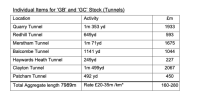Shrop
Member
- Joined
- 6 Aug 2019
- Messages
- 982
Double deck trains have been discussed on this forum several times, but I can't see any answers to my question, which is simply to ask whether any routes have actually been costed for providing double deck trains?
People on this forum (unlike some journalists and many members of the public) will know that this would be no easy task as tunnels are too small, platforms too high, tracks too close together etc. However, focusing on just one route at a time (as we do when considering electrification), I wonder if any routes (eg. HS1, WCML, MML, ECML, sections of XC, or "just" some suburban routes), have been approximately costed for providing double deck trains? It would be interesting to know how such costs might compare per mile, against the cost of electrification (for example).
As a starter I would guess that London to Bristol might be cheaper due to the tracks having already been set apart when providing for HSTs in the 1970s, and some routes would cost less due to having fewer tunnels. So have actual costs per route or per route mile already been discussed?
People on this forum (unlike some journalists and many members of the public) will know that this would be no easy task as tunnels are too small, platforms too high, tracks too close together etc. However, focusing on just one route at a time (as we do when considering electrification), I wonder if any routes (eg. HS1, WCML, MML, ECML, sections of XC, or "just" some suburban routes), have been approximately costed for providing double deck trains? It would be interesting to know how such costs might compare per mile, against the cost of electrification (for example).
As a starter I would guess that London to Bristol might be cheaper due to the tracks having already been set apart when providing for HSTs in the 1970s, and some routes would cost less due to having fewer tunnels. So have actual costs per route or per route mile already been discussed?

